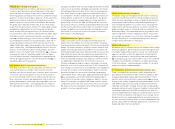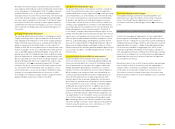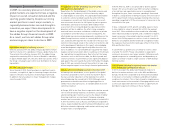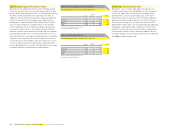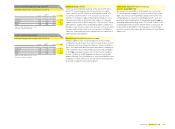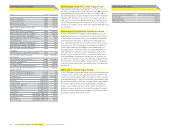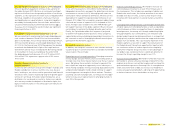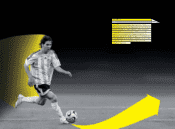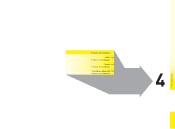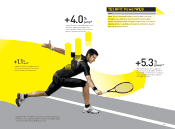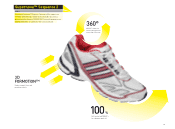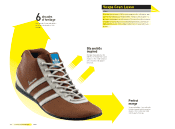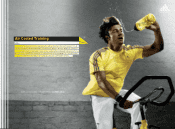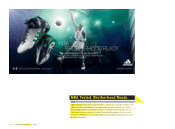Reebok 2008 Annual Report Download - page 129
Download and view the complete annual report
Please find page 129 of the 2008 Reebok annual report below. You can navigate through the pages in the report by either clicking on the pages listed below, or by using the keyword search tool below to find specific information within the annual report.
adidas Group Annual Report 2008 125
Effi cient liquidity management in place for 2009 and beyond
Effi cient liquidity management continues to be a priority for
the adidas Group in 2009. We focus on continuously anticipat-
ing the cash infl ows from the operating activities of our Group
segments, as this represents the main source of liquidity within
the Group. Liquidity is forecasted on a multi-year fi nancial
and liquidity plan on a quarterly basis. Long-term liquidity is
ensured by continued positive free cash fl ows and suffi cient
unused committed and uncommitted credit facilities see
Treasury, p. 093. Consequently, we do not plan any signifi cant
fi nancing initiatives in 2009.
Management to propose unchanged dividend of € 0.50
We are committed to maintaining the Group’s dividend payout
ratio corridor of between 15 and 25% of net income attribut-
able to shareholders. At our Annual General Meeting on May 7,
2009, we intend to propose an unchanged dividend per share
of € 0.50 for the fi nancial year 2008. Management has decided
to maintain the dividend level in light of the tough business
environment and our focus on reducing net borrowings. Based
on the number of shares outstanding at the end of 2008,
the dividend payout will decrease 2% to € 97 million (2007:
€ 99 million). This represents a payout ratio of 15% versus
18% in 2007.
Potential changes in legal structure due to
subsidiary mergers
In 2009, we will continue to evaluate the merger of adidas and
Reebok subsidiaries in various countries on a case-by-case
basis. In doing so, we strive to realise operational and fi nancial
effi ciencies with a view to maximising long-term growth oppor-
tunities for our Group. In markets where third parties act as
distributors for our brands or control a stake in our subsidi-
aries we may consider the buyback of distribution rights, the
buyout of minority stakes or the setting up of joint ventures for
our brands.
Increasing momentum for adidas Group in 2010 and beyond
In line with the projections of the OECD, the World Bank and
independent researchers, we expect the global macroeconomic
environment to recover in 2010, although growth rates are
estimated to remain well below 2008 levels. We forecast this
development to support the operational performance of our
Group in 2010. Under this assumption, we project adidas Group
sales and net income to improve in 2010 compared to 2009
levels. Football sales related to the 2010 FIFA World Cup™
will support revenues in the adidas segment. We also forecast
our initiatives to revitalise the Reebok brand to gain traction.
Finally, the TaylorMade-adidas Golf segment is projected
to benefi t from leading market positions in key categories,
supported by continuously bringing new product innovations to
the consumer as well as leveraging the benefi t we anticipate
gaining from the Ashworth acquisition.
Key goals for long-term success
In addition, the Group will continue to work towards reaching
our priority goals to achieve long-term sustainable shareholder
value creation. These include:
Expand presence in emerging markets: Emerging economies
in Asia, Europe and Latin America have consistently grown at
stronger rates than more mature markets over the last several
years. We believe these markets continue to represent the
most signifi cant long-term opportunity to our industry as a
whole. Rising standards of living, increasing disposable income
and positive demographic trends should continue to support
increasing private consumption in these markets. Therefore,
assuming constant exchange rates, our Group sees the oppor-
tunity to increase our representation in emerging markets to
over 35% of Group sales.
Intensify controlled space focus: We intend to increase our
controlled space initiatives to at least 35% of Group sales in
the coming years. This includes new openings of adidas and
Reebok own-retail stores, the further extension of our mono-
branded store base in China, as well as new shop-in-shop
initiatives with retail partners in several markets around the
world.
Leverage growth and operational scale through to bottom line:
A higher exposure to emerging markets as well as expanding
controlled space activities are important levers to improving
brand presence, increasing sell-through and driving higher
Group profi tability. Our continued focus on innovation and
design leadership and marketing excellence is an important
Group priority to protect and increase the image and consumer
appeal of all our brands. This is particularly important in the
Reebok segment, as we work to support the revitalisation of
the Reebok brand. Taking these opportunities together with
our continuous efforts to reduce organisation complexity
and further integrate Group structures to take advantage of
our global scale, we believe there is signifi cant potential to
increase the Group’s operating margin to over 11%.
Increase fi nancial fl exibility: We intend to further decrease net
borrowings to achieve a fi nancial leverage of below 50% in the
medium term. Excess cash will be largely used to achieve this
goal and reduce exposure to fi nancing risks. A strong balance
sheet and a lower level of debt also increase our fl exibility to
realise value-generating medium- and long-term opportunities
in the best interests of our shareholders as they arise.





